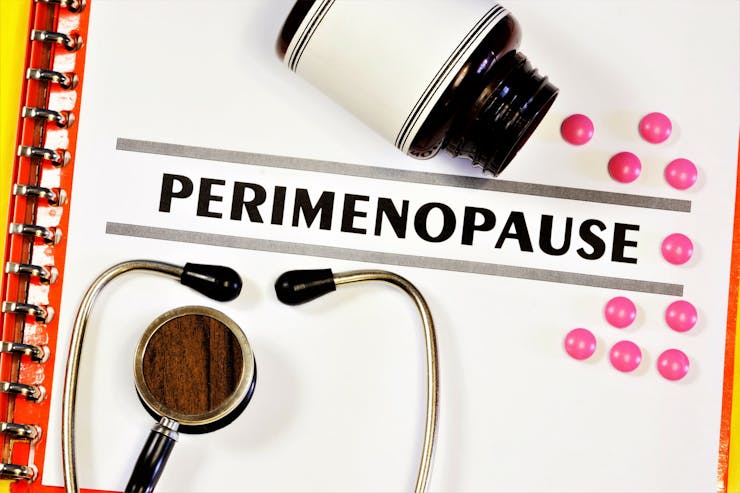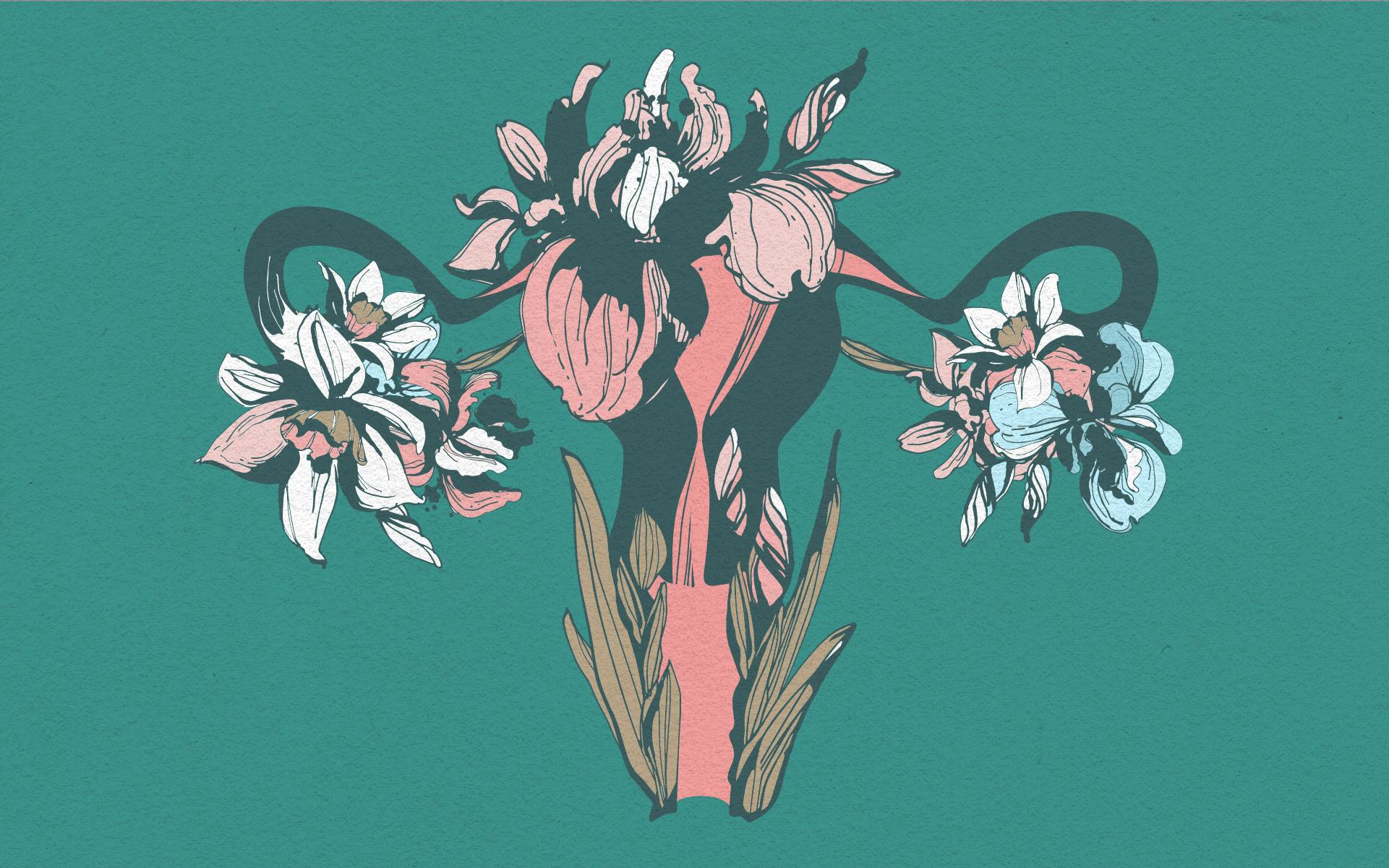When Amber Dawn Mailhoit, 38, recently missed a period she immediately thought she was pregnant, even though her husband’s vasectomy was years ago. “Stranger things have happened,” says the Kelowna mother of two teens.
She started noticing other symptoms, too: sleep disturbances, body aches and cramping that “just came out of nowhere.” When Mailhoit experienced a second missed period, accompanied by dizzy spells and strong cramps, she knew there was something more going on.
“So, I Googled until there were no menopause sites left for me to read and eventually came to the conclusion that I was, indeed, in perimenopause.”

Living with endometriosis, Mailhoit is used to dealing with a measure of pain about three weeks out of every four—a ripping, burning feeling all around her abdomen area. In her experience, cannabis has been the most effective in relieving endometriosis symptoms.
Since Mailhoit already used cannabis to manage endometriosis-related pain, it was her first go-to to ease these new, intense uterine cramps. “I’ll have just a few puffs of a joint and within minutes I’m feeling relaxed, my uterine muscles quiet down, and I can focus on my breathing enough to calm much of the pain.”
By self-medicating with cannabis, she says she’s found her own way to get quality of life back, using it on an as-need basis for pain management and to help with sleep.
“Cannabis has given me a way of coping with perimenopause, allowing me to be the leader in my life and giving me the ability to manage my symptoms without added medications,” she says, noting she will, on occasion, take Advil as a last resort.
Perimenopause starts when exactly?
Everyone with a uterus—roughly 51% of the global population—knows that at some point in midlife their periods will stop. According to the North American Menopause Society, the average age of menopause is 51.
While Mailhoit may seem on the young side for menopause she is within a normal range for perimenopause, a transition phase that begins anywhere between four to eight years before that final menstrual period, which happens anytime between the age of 40 and 58.
Shop highly rated dispensaries near you
Showing you dispensaries nearA recent University of Alberta survey of 1,500 women—68% of whom were peri- or post-menopausal—shared Mailhoit’s symptoms of cramping, lack of sleep, night sweats, hot flashes and muscle aches.

The top-five reported reasons for using cannabis included sleep (65%), anxiety (45%), muscle or joint aches (33%), irritability (29%) and depression (25%).
Coleen Nolan, medical program director for Aqualitas and a registered dietician, says one-third of the perimenopausal group also reported using cannabis for symptom management within the last 30 days.
“This Canadian survey found similar results to a previous smaller study done in the US with 232 perimenopausal military veterans, 27% of whom reported using cannabis to ease symptoms with another 10% saying they wanted to try it,” says Nolan.
What the evidence says—for now
While there is a growing body of anecdotal information supporting cannabis use for perimenopausal symptoms, Nolan says scientific research just isn’t there yet with demonstrated safety and efficacy.
This explains why some healthcare professionals might be hesitant to suggest cannabis for symptom management. Nolan said in a recent review by Canadian researchers, just three small cannabis-perimenopause studies were available for them to examine.
Their conclusion? “More research is needed.”
Some medical doctors are, however, warming up to cannabis for easing the years-long transition into menopause. California-based integrative gynecologist Dr. Felice Gersh has been quoted saying “cannabis products do offer an alternative to what’s out there.”
And by “out there” she means hormone replacement therapy (HRT). Mainstream medicine’s go-to offering for relief of menopause-related symptoms. Another option is anti-depressants. Both of these medicines come with considerable side effects.
As medical director for Aqualitas, Nolan stresses that people experiencing perimenopausal symptoms should first consult a healthcare practitioner to determine if cannabis is a good fit.
Not only are major cannabinoids THC and CBD tolerated differently by everyone, but it’s also a good idea to rule out more serious conditions that could be causing symptoms.
Where does cannabis fit?
Anecdotal evidence suggests hormones influence how cannabis is felt in the body. Ashleigh Brown, patient advocate and CEO of SheCann Cannabis, says 92% of SheCann’s membership base have reported both symptom variation and a changed response to cannabis, based on where they are in their cycle.
“The ebb and flow of reproductive hormones definitely have an impact on our patient population and their symptoms. Over the years, SheCann has noticed patterns in the way that our members’ bodies respond to cannabis during our cycles, too.”
Among her SheCann members, which are just over 10,000 strong, Brown says those in perimenopause and menopause have reported parallels between fluctuating hormone levels and felt effects of cannabis.
“The combination of the two can be unpredictable, especially when trying to manage symptoms such as insomnia…It’s not something that gets discussed very often, and it’s really validating for us to dialogue on this and learn that we aren’t alone.”
“We definitely need to see more research and education on cannabis and reproductive hormones.”

Despite the lack of conclusive evidence through randomized clinical trials, “the gold-standard of medical research” says Nolan, thousands are still turning to cannabis to manage perimenopause symptoms.
Apart from re-emphasizing a consult with a healthcare practitioner (who can be a family doctor or someone from a cannabis health clinic), Nolan advises the ‘start low, go slow’ guidance from Health Canada and other experts are “definitely important to keep top of mind.”
A registered dietitian, Nolan also strongly advises maintaining a healthy lifestyle—a science-supported fact: lowered alcohol intake, exercise, contemplative activities such as a walk in the woods, eliminating cigarettes and a healthy diet can all help alleviate perimenopausal health issues.
As for Mailhoit, she is now getting a full night’s sleep while the cramps, muscle soreness and backaches have all improved dramatically. And while cannabis works well for her, she admits it may not work for others. “I have relatives who prefer estrogen cream and have never tried cannabis of any kind. You do you,” she says.
“No one can tell you what is going to work best for you, but I’d say if you are looking for relief from symptoms of perimenopause, don’t knock cannabis until you’ve tried it, because you just never know.”








